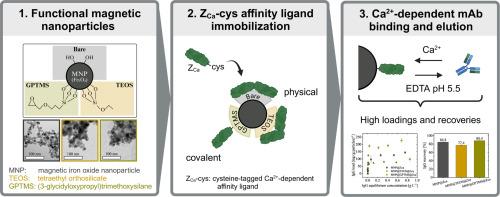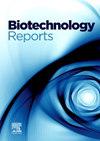将钙依赖的亲和配体固定在氧化铁纳米颗粒上用于弱磁单抗分离
Q1 Immunology and Microbiology
引用次数: 0
摘要
目前单克隆抗体(mAb)的下游加工在吞吐量上是有限的,并且需要苛刻的pH条件才能从Protein A亲和配体中洗脱mAb。在磁分离应用中使用工程钙依赖配体(ZCa),由于温和的洗脱条件,快速的可加工性和过程集成的前景,有望改善。在这项工作中,我们合成并评价了三种用半胱氨酸标记的配体ZCa-cys固定的磁性纳米颗粒类型。将配体同二聚体物理固定在裸氧化铁纳米颗粒(MNP)和正硅酸四乙酯包被的MNP上(MNP@TEOS)。相比之下,ZCa-cys通过半胱氨酸介导的环氧开环反应,共价且更直接地固定在(3-甘油基氧基丙基)三甲氧基硅烷(MNP@GPTMS)包被的MNP上。两种包被的MNP均表现出合适的特性,MNP@TEOS@ZCa-cys具有更大的免疫球蛋白G (IgG)容量(196 mg G - 1), gptms包被的MNP具有更快的磁性吸引和更高的IgG回收率(88%)。这些粒子为依赖钙的磁分离工艺的发展铺平了道路。本文章由计算机程序翻译,如有差异,请以英文原文为准。

Immobilizing calcium-dependent affinity ligand onto iron oxide nanoparticles for mild magnetic mAb separation
Current downstream processing of monoclonal antibodies (mAbs) is limited in throughput and requires harsh pH conditions for mAb elution from Protein A affinity ligands. The use of an engineered calcium-dependent ligand (ZCa) in magnetic separation applications promises improvements due to mild elution conditions, fast processability, and process integration prospects. In this work, we synthesized and evaluated three magnetic nanoparticle types immobilized with the cysteine-tagged ligand ZCa-cys. Ligand homodimers were physically immobilized onto bare iron oxide nanoparticles (MNP) and MNP coated with tetraethyl orthosilicate (MNP@TEOS). In contrast, ZCa-cys was covalently and more site-directedly immobilized onto MNP coated with (3-glycidyloxypropyl)trimethoxysilane (MNP@GPTMS) via a preferential cysteine-mediated epoxy ring opening reaction. Both coated MNP showed suitable characteristics, with MNP@TEOS@ZCa-cys demonstrating larger immunoglobulin G (IgG) capacity (196 mg g−1) and the GPTMS-coated particles showing faster magnetic attraction and higher IgG recovery (88 %). The particles pave the way for the development of calcium-dependent magnetic separation processes.
求助全文
通过发布文献求助,成功后即可免费获取论文全文。
去求助
来源期刊

Biotechnology Reports
Immunology and Microbiology-Applied Microbiology and Biotechnology
CiteScore
15.80
自引率
0.00%
发文量
79
审稿时长
55 days
期刊介绍:
Biotechnology Reports covers all aspects of Biotechnology particularly those reports that are useful and informative and that will be of value to other researchers in related fields. Biotechnology Reports loves ground breaking science, but will also accept good science that can be of use to the biotechnology community. The journal maintains a high quality peer review where submissions are considered on the basis of scientific validity and technical quality. Acceptable paper types are research articles (short or full communications), methods, mini-reviews, and commentaries in the following areas: Healthcare and pharmaceutical biotechnology Agricultural and food biotechnology Environmental biotechnology Molecular biology, cell and tissue engineering and synthetic biology Industrial biotechnology, biofuels and bioenergy Nanobiotechnology Bioinformatics & systems biology New processes and products in biotechnology, bioprocess engineering.
 求助内容:
求助内容: 应助结果提醒方式:
应助结果提醒方式:


